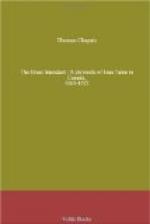Talon saw at a glance the anomaly of the situation; but, being a practical man, he was less displeased with the falsity of the principle than apprehensive of the evil that was likely to result. In a letter to Colbert, dated October 4, 1665, he discussed the subject at length, putting it in plain terms. If, when the grant was made, it was the king’s intention to benefit only the company—to increase its profits and develop its trade—with no ulterior consideration for the development of the colony, then it would be well to leave to the company the sole ownership of the country. But if His Majesty had thought of making Canada one of the prosperous parts of his kingdom, it was very doubtful whether he could attain that end without keeping in his own hands the control of lands and trade. The real aim of the West India Company, as he had learned, was to enforce its commercial monopoly to the utmost; and become the only trading medium between the colony and the mother country. Such a policy could have but one result; it would put an end to private enterprise and discourage immigration.
In spite of the company’s apparent overlordship, Talon thought that, as the king’s agent, he was bound to exercise the powers appertaining to his office for the good of the colony. By the end of the year 1665 he had planned a new settlement in the vicinity of Quebec on lands included in the limits of the seigneury of Notre-Dame-des-Anges at Charlesbourg, which he had withdrawn from the grant to the Jesuits, under the king’s authority. This was the occasion of some friction between the Jesuits and the intendant. Talon gave the necessary orders for the erection of about forty dwellings which should be ready to receive new settlers during the following year. These were to be grouped in three adjacent villages named Bourg-Royal, Bourg-la-Reine, and Bourg-Talon. We shall learn more of them in a following chapter.




